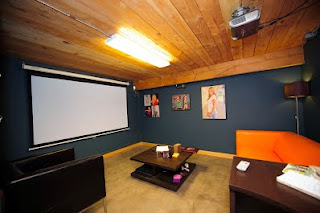Before we can properly answer this question, let's take a moment to describe the current High Definition Display technologies. After that, we'll list out the Pros and Cons to help us be more informed and make a better overall decision.
**Note: we are leaving 'Tube TVs' or old CRT televisions out of this discussion. No doubt there have been many fine models made over the years, but we'll restrict the discussion to HDTV since we assume we all want higher picture resolution, the newest audio/video connections on the TV and may also want to save space, so simply put, we want to know whether to upgrade our existing HDTV to a new one.
Current HDTV Display Technologies
1) Projection('Front' or 'Rear') - A Video Projector, also known as a 'Digital Projector', may, whether mounted on a ceiling or placed on a desktop, project an image onto a traditional reflective screen so built for projection('Front'), or it may be built into a cabinet with a translucent rear-projection screen ('Rear'). In either case these 2 parts form a single device for display, made up of (1) a projection device and (2) a screen.
**Note: Mitsubishi, the last maker of rear-projection TVs, ceased producing them in December 2012.
 |
(Ceiling Mounted 'Front' Video Projector w/retractable screen)
|
2) Plasma - A plasma display panel is a type of flat panel display that is usually larger than 32 inches diagonally measured. Plasma technology utilizes millions of small cells that contain electronically charged ionized gases, chambers often referred to as 'fluorescent lamps', that collectively form a visual image on the display.
3) LCD - A 'Liquid Crystal Display' or LCD display uses the light-modulating properties of liquid crystals to produce images. The picture quality comes from 'TFT' (Thin-Film-Transistor) LCD technologies.
4) LED - Refers to the type of backlighting used for an LCD TV. Traditional LCD TV's use CCFL (Cold Cathode Fluorescent) backlighting, which may be a tad bulkier and consume more power. An LED/LCD TV refers to a TV which still uses the TFT picture technology, but employs an array or cluster of LED's for its backlighting. As you can see this can cause some confusion. In fact if you see an ad today for an LED TV, remember it is actually an LED/LCD TV. The industry has (for now) allowed companies to get away with just using the 'LED' tag, which was started fairly recently by Samsung and went on from there.
 |
Pictured: 32 inch LED/LCD TV
|
OK, so enough of this technical stuff, let's get to the comparisons. Hopefully you'll find out something you did not know before...and be better prepared on whether to keep or ditch your existing HDTV for a new one.
HDTV Display Technologies - Pros and Cons
Projection TVs
Pros - can be much cheaper than flat-panel TVs, Front-projection picture quality is outstanding and 'cinema like', Front-projectors and screens take up little space. Rear-projectors are not susceptible to burn-in (LCD/DLP ones) and glare (all types of rear-projection TVs).
Cons - Front-projectors are difficult to set up/mount, Lamps may have to be replaced after heavy usage for both types (Front and Rear). There are also smaller viewing angles (Front and Rear), and rear-projection TVs are much bulkier than flat-panel TVs.
Plasma TVs
Pros - Thin profile, can be mounted on a wall, lighter and less bulkier than rear-projection TVs, wider viewing angles, even wider than LCD, little or no motion blur, due to inherent high refresh rates and faster response times (up to 1 microsecond), which makes them perfect for action films or sports programs, more accurate color (68 billion vs 17 million for LCD) and superior contrast (up to 1 million to 1) than LCD.
Cons - Early models were susceptible to screen burn-in and image retention, newer models can offset it; they are also susceptible to glare in bright rooms, consume a lot of power, and are heavier than LCD TVs.
LCD TVs
Pros - Thin profile, can be mounted on a wall, lighter and less bulkier than rear-projection TVs, not affected by glare in well-lit rooms, generally consume a little less power than plasma TVs, less likelihood of screen burn-in.
Cons - Poor black levels, which leads to worse contrast ratios and image detail, (which can be offset by LED illumination arrays to improve black levels, hence the impressive 'LED/LCD TVs' described above), narrower viewing angles and some image warping can occur, slower response times than plasmas, that is why we see LCD TVs or LED/LCD TVs on the market with enhanced refresh rates mentioned in their marketing strategies.
So...that's it. Are you surprised by some of this? Maybe so. But our thought is this, unless you have got to have 3DTV and/or have a super-slim panel display with all of the newest features like Smart TV with Internet streaming and such, you may want to stick with what you have for now, unless your TV is say, 6 years old or more and you really like what you see in the store. We suggest you try our cable upgrades and TV adjustments tips first, and if they still don't quite do it for you, then as we say, go to your favorite TV shop and:
'Give it a Try, and Happy Viewing!'
Here you can view an excellent selection of HDTVs!

No comments:
Post a Comment